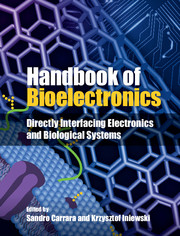Book contents
- Frontmatter
- Contents
- List of Contributors
- 1 What is bioelectronics?
- Part I Electronic components
- Part II Biosensors
- Part III Fuel cells
- Part IV Biomimetic systems
- Part V Bionics
- Part VI Brain interfaces
- Part VII Lab-on-a-chip
- 35 Lab-on-a-chip
- 36 CMOS spectrally multiplexed FRET contact imaging microsystem for DNA analysis
- 37 CMOS electrochemical biosensors: instrumentation and integration
- 38 Adaptive and reconfiguration-based error recovery in cyberphysical biochips
- 39 CMOS-based biomolecular sensor system-on-chip
- Part VIII Future perspectives
- Index
- References
39 - CMOS-based biomolecular sensor system-on-chip
from Part VII - Lab-on-a-chip
Published online by Cambridge University Press: 05 September 2015
- Frontmatter
- Contents
- List of Contributors
- 1 What is bioelectronics?
- Part I Electronic components
- Part II Biosensors
- Part III Fuel cells
- Part IV Biomimetic systems
- Part V Bionics
- Part VI Brain interfaces
- Part VII Lab-on-a-chip
- 35 Lab-on-a-chip
- 36 CMOS spectrally multiplexed FRET contact imaging microsystem for DNA analysis
- 37 CMOS electrochemical biosensors: instrumentation and integration
- 38 Adaptive and reconfiguration-based error recovery in cyberphysical biochips
- 39 CMOS-based biomolecular sensor system-on-chip
- Part VIII Future perspectives
- Index
- References
Summary
Introduction
Biomolecular detection is crucial from various perspectives, such as quality control of our food and water, identification of biological terrorist agents, and diagnosis of diseases. Early detection of disease is important for effective treatment and for prognostic assessment of disease progression; in addition, the trend of ageing societies leads to an increasing requirement for biomarker diagnoses for personalized healthcare monitoring. This results in more stress on the social healthcare system [1, 2]. As a consequence, researchers have focused on developing biomolecular detection devices and systems. Over the past decade, emerging methods to address the above needs have bloomed because of developments in micro/nanotechnologies. To enhance throughputs and reduce costs, moreover, these detection devices and systems are evolving from label-based to label-free technologies.
Traditionally, label-based molecular diagnosis techniques have been used as a useful fundamental concept for the detection of potential disease biomarkers or pathogen nucleic acids. In general, the detection signal comes from the usage of a specific tag for a target molecule. The tags can be conventional fluorescent dyes or radioisotopes. To fulfill the requirements of different applications, a number of conventional label-based techniques, such as polymerase chain reaction (PCR), DNA or protein microarrays, and enzyme-linked immunosorbent assay (ELISA), have been developed and implemented. Some of them have been used to form a versatile platform for many diverse applications with promising results and represent the gold standards of biomedical diagnosis [3–5]. However, these techniques require trained staff and expensive equipment, and are time-consuming. Moreover, the detection of such low-abundance biomarkers in biological fluids (e.g. blood, urine, saliva) requires large quantities of the sample and complicated sample preparation. Consequently, these label-based techniques encounter problems of cost-effectiveness and throughput under modern circumstances.
- Type
- Chapter
- Information
- Handbook of BioelectronicsDirectly Interfacing Electronics and Biological Systems, pp. 489 - 506Publisher: Cambridge University PressPrint publication year: 2015



